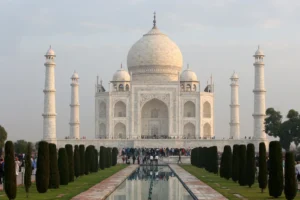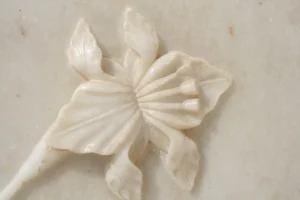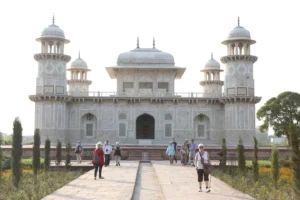Agra
Agra is the city of the Taj Mahal. The foundation of the present city of Agra is attributed to Raja Badal Singh, around 1475 AD. Its mention as Agraban also appears in Mahabharta which suggests that it might have been on the outskirts of Mathura.
 The present city was first made its capital by king Sikander Lodi. Agra gained its importance with the arrival of Mughals in 1526, and achieved its zenith between 1556 and 1658, under the emperors Akber, Jehangir and Shah Jahan (the builder of Taj Mahal). Akber made it a center for learning, art and commerce. His successors continued the tradition and built number of buildings including the famous Taj Mahal. It is not surprising that the modern city of Agra still reflects its Mughal heritage. Though Agra has been long renowened as the city of the Taj Mahal, it has overshadowed the fact that it has a large number of other magnificent monuments which we shall visit.
The present city was first made its capital by king Sikander Lodi. Agra gained its importance with the arrival of Mughals in 1526, and achieved its zenith between 1556 and 1658, under the emperors Akber, Jehangir and Shah Jahan (the builder of Taj Mahal). Akber made it a center for learning, art and commerce. His successors continued the tradition and built number of buildings including the famous Taj Mahal. It is not surprising that the modern city of Agra still reflects its Mughal heritage. Though Agra has been long renowened as the city of the Taj Mahal, it has overshadowed the fact that it has a large number of other magnificent monuments which we shall visit.
Shahjahan built the Taj Mahal – the seventh wonder of the world! – in memory of his beloved wife, Begum Mumtaz Mahal, the ‘lady of the Taj’, who died giving birth to their 14th child. It is a sublime experience of the greatest love story ever told – the most extravagant monument ever built for the sake of love, arguably the most perfect building in all Islam and which, as a monument raised to a queen, defies stereotypes of the place of women in Muslim society. India’s most fascinating and beautiful masterpiece, this perfectly symmetrical edifice, is set amidst landscaped gardens on the banks of the Yamuna. The construction of the Taj commenced in 1631, and was completed in 1653. Workers were gathered from all over the country and from Central Asia, and about 20,000 people were recruited to translate this wild dream into a reality. The main architect was Ustad Isa Khan, who was brought all the way from Shiraz in Iran. After he was deposed and brutally imprisoned in the Agra Fort, by his son Aurangzeb, Shahjahan spent the rest of his life looking wistfully at his wife’s final resting place, just across the river. The Taj has the verses of the holy Quran inscribed on it, with the gate being crowned by 22 small domes, constructed on a 313 square feet marble platform that stands above a sandstone one. The entire portion is enclosed within a high boundary wall with broad octagonal pavilions at corners. The most elegant dome of the monument has a diametre of 60 feet that rises 80 feet over the building. Semi-precious stones are inlaid into the marble in beautiful patterns and with superb craftsmanship in a process known as pietra dura. The Taj Mahal is closed on Fridays.
 After a visit, author Salman Rushdie wrote, “The Taj must be seen; to remind us that the world is real, that the sound is truer than the echo, and the original more forceful than its image in a mirror. The beauty of beautiful things is still able, in these image-saturated times, to transcend imitations. And the Taj Mahal is beyond the power of words to say it, a lovely thing, perhaps the loveliest of things.”
After a visit, author Salman Rushdie wrote, “The Taj must be seen; to remind us that the world is real, that the sound is truer than the echo, and the original more forceful than its image in a mirror. The beauty of beautiful things is still able, in these image-saturated times, to transcend imitations. And the Taj Mahal is beyond the power of words to say it, a lovely thing, perhaps the loveliest of things.”
On the banks of river Yamuna, rises the crescent-like Agra Fort. Designed and built by Emperor Akbar in 1565 A.D., the fort is surrounded by a 70 foot high wall. It houses the beautiful Pearl Mosque and numerous palaces including the Jahangiri Mahal, Khas Mahal, Diwan-i-Khas, Diwan-i-Am, Machihi Bhawan and Moti Masjid. The fort has four gates and is enclosed by a double battlemented wall of red sand stone.
 The Itmad-ud-daulah was the first Mughal structure totally constucted of marble and the first to make extensive use of pietra dura, inlay work of marble which is so much a part of the Taj. The mausoleum is small and squat compared to the soaring Taj, but the smaller, more human scale somehow makes it more attractive, and the beautifully patterned surface of the tomb is superb. There are also extremely fine marble lattice-work passages admitting light to the interior.
The Itmad-ud-daulah was the first Mughal structure totally constucted of marble and the first to make extensive use of pietra dura, inlay work of marble which is so much a part of the Taj. The mausoleum is small and squat compared to the soaring Taj, but the smaller, more human scale somehow makes it more attractive, and the beautifully patterned surface of the tomb is superb. There are also extremely fine marble lattice-work passages admitting light to the interior.
A quarter of an hour north of Agra, is a glorious introduction to the city of Mughal wonders, Sikandra. The site of Akbar’s mausoleum, Sikandra was begun by Akbar and completed by his son Jehangir in 1613 AD. It reflects the fusion of Hindu and Muslim art and architecture which characterised the era. The tomb is situated in the centre of a large garden and four identical red sandstone gates lead to the tomb complex. An impressive marble – inlaid gateway leads to the spacious four – tiered monument which is crowned by a white marble cenotaph and screen. This last was added by Jahangir, who completed the tomb after the demise of his father. Sikandra is named after Sikandra Lodi, the Delhi ruler who was in power from 1488 to 1517.
Ram Bagh was laid by the Emperor Babur, first of the Mughals, in 1528, the earliest Mughal garden. It is said that Babur was buried here before being permanently interred at Kabul in Afghanistan.
Across the railway tracks from the Delhi Gate of Agra Fort, the Jami Masjid was built by Shah Jahan in 1648. An inscription over the main gate indicates that it was built in the name of Jahanara, Shah Jahan’s daughter, who was imprisoned with Shah Jahan by Aurangzeb.
